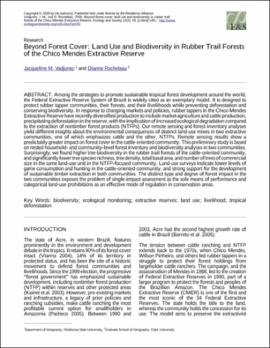| dc.contributor.author | Vadjunec, Jacqueline M. | |
| dc.contributor.author | Rocheleau, Dianne | |
| dc.date.accessioned | 2019-08-22T17:51:01Z | |
| dc.date.available | 2019-08-22T17:51:01Z | |
| dc.date.issued | 2009 | |
| dc.identifier | oksd_vadjunec_beyondforestcov_2009 | |
| dc.identifier.citation | Vadjunec, J. M., & Rocheleau, D. (2009). Beyond forest cover: Land use and biodiversity in rubber trail forests of the Chico Mendes Extractive Reserve. Ecology and Society, 14(2). https://doi.org/10.5751/ES-03010-140229 | |
| dc.identifier.uri | https://hdl.handle.net/11244/321259 | |
| dc.description.abstract | Among the strategies to promote sustainable tropical forest development around the world, the Federal Extractive Reserve System of Brazil is widely cited as an exemplary model. It is designed to protect rubber tapper communities, their forests, and their livelihoods while preventing deforestation and conserving biodiversity. In response to changing markets and policies, rubber tappers in the Chico Mendes Extractive Reserve have recently diversified production to include market agriculture and cattle production, precipitating deforestation in the reserve, with the implication of increased ecological degradation compared to the extraction of nontimber forest products (NTFPs). Our remote sensing and forest inventory analyses yield different insights about the environmental consequences of distinct land-use mixes in two extractive communities, one of which emphasizes cattle and the other, NTFPs. Remote sensing results show a predictably greater impact on forest cover in the cattle-oriented community. This preliminary study is based on nested household- and community-level forest inventory and biodiversity analyses in two communities. Surprisingly, we found higher tree biodiversity in the rubber trail forests of the cattle-oriented community, and significantly lower tree species richness, tree density, total basal area, and number of trees of commercial size in the same land-use unit in the NTFP-focused community. Land-use surveys indicate lower levels of game consumption and hunting in the cattle-oriented community, and strong support for the development of sustainable timber extraction in both communities. The distinct type and degree of forest impact in the two communities exposes the problem of single-impact assessment as the sole means of performance and categorical land-use prohibitions as an effective mode of regulation in conservation areas. | |
| dc.format | application/pdf | |
| dc.language | en_US | |
| dc.publisher | Resilience Alliance | |
| dc.rights | This material has been previously published. In the Oklahoma State University Library's institutional repository this version is made available through the open access principles and the terms of agreement/consent between the author(s) and the publisher. The permission policy on the use, reproduction or distribution of the material falls under fair use for educational, scholarship, and research purposes. Contact Digital Resources and Discovery Services at lib-dls@okstate.edu or 405-744-9161 for further information. | |
| dc.title | Beyond forest cover: Land use and biodiversity in rubber trail forests of the Chico Mendes Extractive Reserve | |
| osu.filename | oksd_vadjunec_beyondforestcov_2009.pdf | |
| dc.description.peerreview | Peer reviewed | |
| dc.identifier.doi | 10.5751/ES-03010-140229 | |
| dc.description.department | Geography | |
| dc.type.genre | Article | |
| dc.type.material | Text | |
| dc.subject.keywords | biodiversity | |
| dc.subject.keywords | ecological monitoring | |
| dc.subject.keywords | extractive reserves | |
| dc.subject.keywords | land use | |
| dc.subject.keywords | livelihood | |
| dc.subject.keywords | tropical deforestation | |
